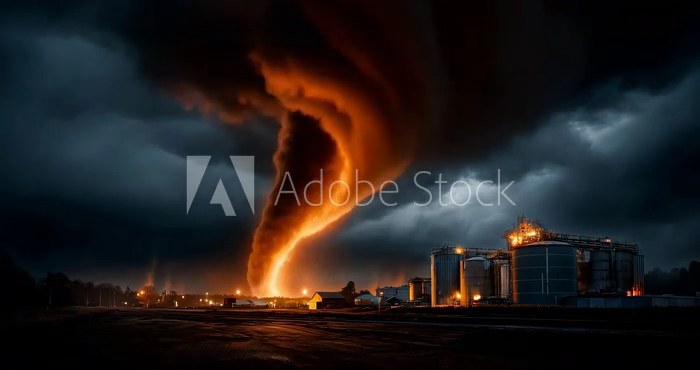Facing Nature’s Fury: When Fire Tornadoes Threaten Industrial Zones
In a world increasingly vulnerable to extreme weather and climate-induced disasters, few images are as striking and unsettling as the one above. A blazing fire tornado twists ominously through a darkened sky, heading straight toward an industrial facility. This isn’t just a photograph—it’s a powerful statement about risk, preparedness, and the evolving challenges of environmental safety.
As such, for industries involved in disaster recovery, emergency planning, weather monitoring, or industrial risk management, this image delivers an unforgettable message. It symbolizes both the raw force of nature and the urgent need for resilient infrastructure.
The Phenomenon: What Is a Fire Tornado?
To understand the gravity of this image, it’s important to first define what we’re seeing. A fire tornado—also known as a firenado—is a rare yet dangerous phenomenon that occurs when intense heat from a fire rises rapidly, creating a vortex of flames and wind. While they may resemble traditional tornadoes, fire tornadoes are often more localized but equally destructive.
Moreover, these fiery cyclones are fueled by dry conditions, high temperatures, and turbulent winds—all of which are becoming more common due to climate change. Consequently, areas near oil refineries, chemical plants, or industrial storage facilities are at even higher risk, as the potential for combustion is amplified.
This makes the image not only terrifying but also extremely relevant to current environmental and industrial concerns.
Why This Image Matters for Industry
Transitioning from the natural phenomenon itself to its implications, this image raises serious concerns for businesses operating in high-risk zones. Industrial plants—especially those dealing with flammable substances—must contend with a new reality: natural disasters are no longer rare. They’re frequent, intense, and often unpredictable.
Therefore, safety measures such as:
- Emergency shutdown protocols
- Fire-resistant structural designs
- Real-time weather monitoring systems
- Employee evacuation planning
- Coordination with local firefighting units
…are no longer optional—they are essential.
Additionally, regulatory bodies and insurance firms are now requiring stricter compliance with disaster-preparedness standards, especially in sectors like petroleum, manufacturing, and logistics.
SEO Keywords to Strengthen Visibility
To ensure this content reaches the right audience through search engines, it’s vital to include strategic, relevant keywords. Here are some SEO-optimized phrases to consider integrating across your website:
- Fire tornado near industrial facility
- Industrial disaster preparedness
- Extreme weather risk management
- Firenado emergency response
- Tornado damage mitigation plan
- Natural disaster and infrastructure safety
- Industrial fire hazard response
- Climate change disaster impact
For alt text, use:
“Massive fire tornado approaching industrial plant under stormy skies.”
By weaving these keywords naturally into the page, you improve your visibility to engineers, risk managers, policy makers, and emergency planners searching for related topics.
How to Use This Image in Web Content
The value of this powerful visual extends far beyond its aesthetic. Here are a few strategic ways to use this image effectively in your content:
1. Corporate Safety Pages:
Reinforce your company’s commitment to safety and preparedness.
2. Emergency Planning Blog Posts:
Use it as a feature image in an article about handling extreme weather events in industrial zones.
3. Environmental Impact Reports:
Visualize the threats posed by climate-driven disasters in whitepapers or downloadable reports.
4. Social Media Awareness Campaigns:
Spark engagement by raising awareness of climate hazards and the importance of emergency readiness.
5. Training Materials for Employees:
Include it in presentations or e-learning modules focused on evacuation procedures and situational awareness.
Technology and Solutions for Mitigation
Even though natural disasters like fire tornadoes are largely out of human control, innovative technologies and protocols can significantly reduce their impact. From automated fire suppression systems to real-time satellite weather monitoring, industries now have access to tools that make preparedness more proactive than reactive.
In addition, using artificial intelligence for predictive analytics allows companies to assess vulnerabilities long before disaster strikes. As a result, they can allocate resources efficiently, reduce downtime, and most importantly, protect lives and assets.
A Wake-Up Call for Climate Resilience
Ultimately, this image is a wake-up call. It reminds us that climate resilience is no longer a future goal—it’s a current necessity. The combination of an ominous sky, a spinning vortex of flame, and a vulnerable industrial facility captures the urgency better than any statistics ever could.
Furthermore, as governments and private sectors push toward sustainability and risk reduction, visuals like this serve as compelling evidence of the stakes involved.
Conclusion: Prepare for the Unpredictable
In conclusion, the image of a fire tornado barreling toward an industrial zone is more than just a visual—it’s a symbol of the volatile intersection between nature and industry. For businesses, emergency responders, and policy makers alike, it underscores the critical need for planning, innovation, and resilience.
Because ultimately, while we cannot prevent nature’s fury, we can certainly prepare for it. And by doing so, we turn chaos into caution—and risk into readiness.



